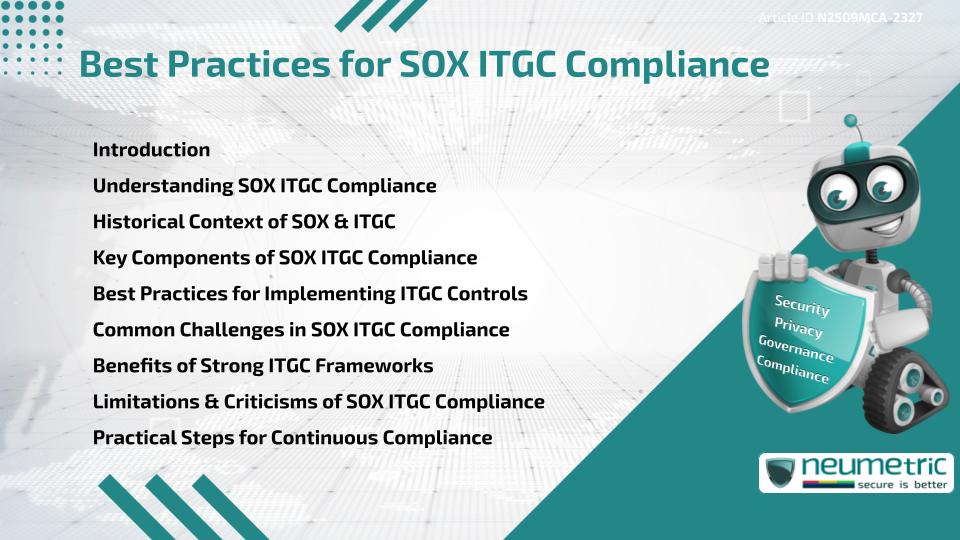Table of Contents
ToggleIntroduction
SOX ITGC Compliance is a critical aspect of modern Financial Governance, ensuring that companies maintain Integrity, Security & Reliability in their Financial reporting. It focuses on Information Technology General Controls [ITGC] under the Sarbanes-Oxley Act [SOX], which regulates Access, System operations & Data Integrity. Adopting Best Practices for SOX ITGC Compliance helps Organisations prevent fraud, safeguard Sensitive Information & meet Regulatory requirements. This article explores the historical context, essential components, practical strategies, common challenges & benefits associated with SOX ITGC Compliance.
Understanding SOX ITGC Compliance
SOX ITGC Compliance revolves around ensuring that IT systems support Accurate & Trustworthy Financial reporting. ITGC includes Access Controls, Change Management, System Operations & Data Backup. These controls form the foundation for other business processes & ensure that Financial data is reliable. Without strong ITGC, Financial statements Risk becoming inaccurate or vulnerable to manipulation.
Historical Context of SOX & ITGC
The Sarbanes-Oxley Act was introduced in 2002 after corporate scandals such as Enron & WorldCom. Its primary aim was to restore investor confidence in publicly traded companies. While Financial Accountability was at the core, IT systems quickly became part of Compliance discussions since Financial data increasingly relied on technology. ITGC emerged as a cornerstone of SOX implementation, bridging technology & Finance in a way that ensures integrity at every level.
Key Components of SOX ITGC Compliance
SOX ITGC Compliance consists of four main components:
- Access Controls: Ensuring only authorised users access Critical Financial data.
- Change Management: Tracking & approving modifications in systems to prevent unauthorised changes.
- System Operations: Monitoring & Managing IT systems to guarantee uptime & accuracy.
- Data Backup & Recovery: Protecting Data Integrity through effective backup & recovery procedures.
Each of these areas reduces Risk & supports accurate reporting.
Best Practices for Implementing ITGC Controls
Organisations can strengthen SOX ITGC Compliance by following several Best Practices:
- Segregation of Duties: Assigning different responsibilities for authorisation, recordkeeping & system administration to prevent conflicts of interest.
- Automated Monitoring: Using tools to continuously track system activities & alert on anomalies.
- Regular Testing: Conducting periodic Audits & testing ITGC Controls for effectiveness.
- Documentation: Maintaining detailed Records of Procedures, Changes & Approvals.
- Training: Educating Employees on their roles in Compliance & Security.
These practices create a strong Framework that promotes Accountability & Efficiency.
Common Challenges in SOX ITGC Compliance
Despite its importance, Organisations often struggle with:
- Complexity in large IT environments.
- High costs of implementing & maintaining Controls.
- Resistance from staff who view Compliance as burdensome.
- Difficulty aligning IT & business teams on Compliance goals.
Overcoming these challenges requires strong leadership, effective communication & ongoing investment in resources.
Benefits of Strong ITGC Frameworks
A robust SOX ITGC Compliance program provides multiple benefits beyond regulatory requirements:
- Enhanced Trust from Investors & Stakeholders.
- Reduced Risk of fraud & Financial misstatements.
- Improved operational efficiency through streamlined IT processes.
- Stronger Data Security & resilience against Cyber Threats.
These benefits position Organisations not only for Compliance but also for sustainable growth.
Limitations & Criticisms of SOX ITGC Compliance
Critics of SOX ITGC Compliance argue that it imposes significant Financial & Administrative burdens, especially on smaller firms. Some also claim that Compliance may create a checkbox mentality, where Organisations focus more on passing Audits than on actual Risk reduction. Despite these concerns, most agree that the benefits of Compliance outweigh its drawbacks in terms of Transparency & Accountability.
Practical Steps for Continuous Compliance
Continuous Compliance is achieved by embedding ITGC into daily operations rather than treating it as a yearly Audit exercise. Practical steps include:
- Conducting Self-assessments throughout the year.
- Updating ITGC procedures to match evolving technology.
- Using dashboards for real-time Compliance tracking.
- Encouraging collaboration between Finance & IT departments.
This proactive approach ensures Compliance is sustainable & adaptable.
Takeaways
- SOX ITGC Compliance builds Trust, Security & Financial accuracy.
- Strong ITGC frameworks reduce fraud & data Risks.
- Best Practices include segregation of duties, monitoring & documentation.
- Challenges include cost, complexity & staff resistance.
- Continuous Compliance requires proactive Self-assessments & Collaboration.
FAQ
What is SOX ITGC Compliance?
It refers to adherence to the Sarbanes-Oxley Act’s requirements for Information Technology General Controls, ensuring reliable Financial reporting.
Why is SOX ITGC Compliance important?
It helps prevent fraud, safeguards sensitive Financial data & ensures the accuracy of Financial reporting.
What are examples of ITGC controls?
Examples include Access Management, System Monitoring, Change control & Data Backup procedures.
How often should ITGC controls be tested?
Controls should be tested at least annually, though many Organisations perform quarterly or continuous assessments.
Who is responsible for SOX ITGC Compliance?
Responsibility is shared across IT teams, Finance departments, internal auditors & executive leadership.
What are common challenges in Compliance?
Challenges include complex IT environments, high costs & aligning IT with business priorities.
Can automation help in SOX ITGC Compliance?
Yes, automation reduces manual errors, improves monitoring & enhances efficiency in Compliance processes.
Need help for Security, Privacy, Governance & VAPT?
Neumetric provides organisations the necessary help to achieve their Cybersecurity, Compliance, Governance, Privacy, Certifications & Pentesting needs.
Organisations & Businesses, specifically those which provide SaaS & AI Solutions in the Fintech, BFSI & other regulated sectors, usually need a Cybersecurity Partner for meeting & maintaining the ongoing Security & Privacy needs & requirements of their Enterprise Clients & Privacy conscious Customers.
SOC 2, ISO 27001, ISO 42001, NIST, HIPAA, HECVAT, EU GDPR are some of the Frameworks that are served by Fusion – a SaaS, multimodular, multitenant, centralised, automated, Cybersecurity & Compliance Management system.
Neumetric also provides Expert Services for technical security which covers VAPT for Web Applications, APIs, iOS & Android Mobile Apps, Security Testing for AWS & other Cloud Environments & Cloud Infrastructure & other similar scopes.
Reach out to us by Email or filling out the Contact Form…


